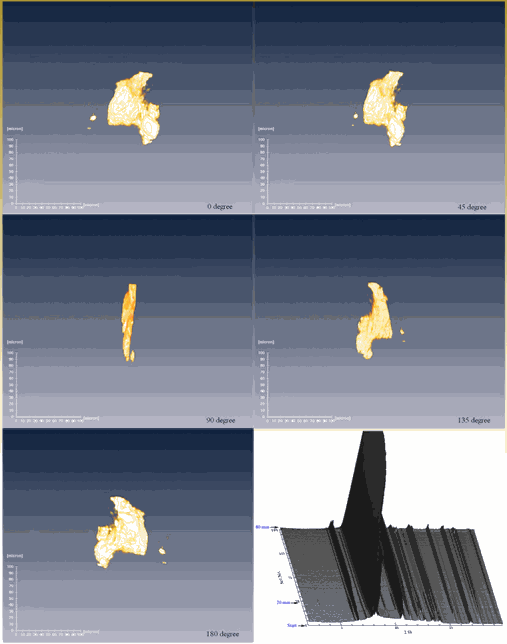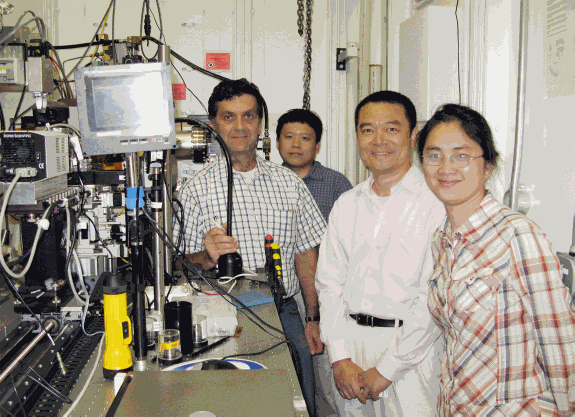The behavior of materials under extreme conditions of pressure, temperature, and magnetic fields is an important area of investigation in the materials sciences and a key to developing new materials with superior qualities. Researchers using an x-ray beamline at the Advanced Photon Source (APS) at the U.S. Department of Energy’s Argonne National Laboratory employed a new technique developed at another APS beamline to examine amorphous (non-crystalline) selenium (a-Se) under great pressure. Their results answer a long-standing question about the electrical properties a-Se exhibits when subjected to extreme pressure, and show that the new x-ray technique holds great promise for gaining insights about the properties of materials under those conditions.
In the 1970s, a-Se (a model system for examining pressure effects in amorphous materials) was found to crystallize in a trigonal structure (t-Se) at pressures of approximately 10 gigapascals (GPa). However, the electrical resistance of a-Se was clearly different from that of pure t-Se in the same pressure range. At pressures where crystallization occurs, in situ electrical resistance measurements of a-Se showed a discontinuous drop in resistance, resulting in a resistance 2 to 3 orders of magnitude smaller than that of t-Se at the same pressure. More curious was the revelation that electrical resistance increased unexpectedly with time when the pressure was held constant during crystallization. This discrepancy between the electrical resistance and structure of t-Se prompted further investigation into the nature of pressure-induced crystallization using x-ray diffraction (XRD) techniques.
The researchers in this study, from the Harbin Institute of Technology (HIT), Argonne National Laboratory, Harvard University, and the Geophysical Laboratory of the Carnegie Institution of Washington, discovered an unexpected dynamic crystallization process associated with a volume expansion in a-Se when the material was subjected to extreme pressure. The origin of this unusual phenomenon was investigated using the newly developed high-pressure x-ray microtomography technique, which allowed direct measurement of the equation of state (EOS) of the amorphous phase. The study was published in the Proceedings of the National Academy of Sciences of the United States of America.
“The high x-ray flux from APS was essential for rapidly probing the sample when using diamond-anvil cells (DAC) to produce the desired pressure in the correct time domain,” said Haozhe Liu, Professor of Physics at HIT and the lead scientist of this study. “This property of the APS x-ray beam ensured that we could successfully perform time-resolved XRD measurements at the 16-ID-B beamline of the High Pressure Collaborative Access Team.”
From the in situ XRD patterns taken in short time intervals with a finely focused x-ray beam, the researchers monitored the appearance and the re-crystallization between a metastable monoclinic Se (m-Se) phase and the t-Se phase in the time and spatial domain within the sample. The monoclinic phase persisted from 20 minutes to over hours at different locations in the sample. A pure trigonal phase could be observed at most locations about 80 minutes after the start of crystallization.
The density change of the material during crystallization is a crucial measurement, because the density of metastable m-Se appears to be about 3.6% higher than that of t-Se, based on the structure refinement. To measure the density of a noncrystalline material under pressure, a new method was developed using synchrotron x-ray tomography. “The new high-pressure microtomography technique developed at X-ray Operations and Research (XOR) beamline 2-BM at the APS used beryllium gaskets that are transparent to x-rays, together with a panoramic DAC that imaged the sample in three dimensions,” said Xianghui Xiao of XOR. “This technique allowed a precise measurement of the pressure-volume EOS of amorphous materials inside the DAC."
“It was extremely exciting,” said HIT’s Liu, “to see, for the first time, a three-dimensional-imaging movie of the sample in the DAC after tomographic reconstruction. It was even more exciting to discover that the novel x-ray microtomographic technique revealed the time dependence of the molar volume change and volume expansion under pressure associated with the crystallization. This pressure-induced volume expansion phenomenon differs from those associated with chemical changes, for example in zeolites, which are caused by the pressure-induced hydration sorption of water from the pressure-transmission fluid. In contrast, the crystallization found here involves local topological fluctuations in an elemental system.”
These results reveal the structural origin of the long-standing enigma of time-dependent electrical properties of a-Se on compression. The unusual volume expansion phenomenon under pressure associated with the recrystallization of “over-pressurization” of a metastable phase may be more common than previously believed. Moreover, tuning relative densities and energetics of phases in this way may provide a new route for creating new structures from highly metastable states.
The new x-ray microtomographic technique could find widespread use in accurate determinations of the EOS of glasses and melts up to megabar pressures, which is crucial to many problems in Earth, planetary, and materials sciences. The results demonstrate the importance of using new time- and spatially- resolved high-pressure x-ray diffraction and imaging techniques to understand the kinetics of structural transformations in materials under extreme conditions.
Contact: Haozhe Liu, [email protected]
See: Haozhe Liu, Luhong Wang, Xianghui Xiao, Francesco De Carlo, Ji Feng, Ho-kwang Mao, and Russell J. Hemley, “Anomalous high-pressure behavior of amorphous selenium from synchrotron x-ray diffraction and microtomography,” Proc. Nat. Acad. Sci. USA. 105 (36), 13229 (2008). DOI: 10.1073_pnas.0806857105
The high-pressure research team at HIT is supported by the Program for New Century Excellent Talents in China and the Excellent Team Program in HIT. The High Pressure Collaborative Access Team facility is supported by the U. S. Department of Energy, Office of Science, Office of Basic Energy Sciences (DOE–BES), the DOE Office of Nuclear and National Security Information (Carnegie DOE Alliance Center), the National Science Foundation, the Department of DefenseTactical Army Command, and the W. M. Keck Foundation. Use of the Advanced Photon Source at Argonne National Laboratory was supported by the DOE-BES, under Contract No. DE-AC02-06CH11357,
Argonne National Laboratory brings the world's brightest scientists and engineers together to find exciting and creative new solutions to pressing national problems in science and technology. The nation's first national laboratory, Argonne conducts leading-edge basic and applied scientific research in virtually every scientific discipline. Argonne researchers work closely with researchers from hundreds of companies, universities, and federal, state and municipal agencies to help them solve their specific problems, advance America 's scientific leadership and prepare the nation for a better future. With employees from more than 60 nations, Argonne is managed by UChicago Argonne, LLC for the U.S. Department of Energy's Office of Science.


